Intel's X25-V & Kingston's 30GB SSDNow V Series: Battle of the $125 SSDs
by Anand Lal Shimpi on March 19, 2010 12:00 AM EST- Posted in
- Storage
Overall System Performance using PCMark Vantage
Next up is PCMark Vantage, another system-wide performance suite. For those of you who aren’t familiar with PCMark Vantage, it ends up being the most real-world-like hard drive test I can come up with. It runs things like application launches, file searches, web browsing, contacts searching, video playback, photo editing and other completely mundane but real-world tasks. I’ve described the benchmark in great detail before but if you’d like to read up on what it does in particular, take a look at Futuremark’s whitepaper on the benchmark; it’s not perfect, but it’s good enough to be a member of a comprehensive storage benchmark suite. Any performance impacts here would most likely be reflected in the real world.
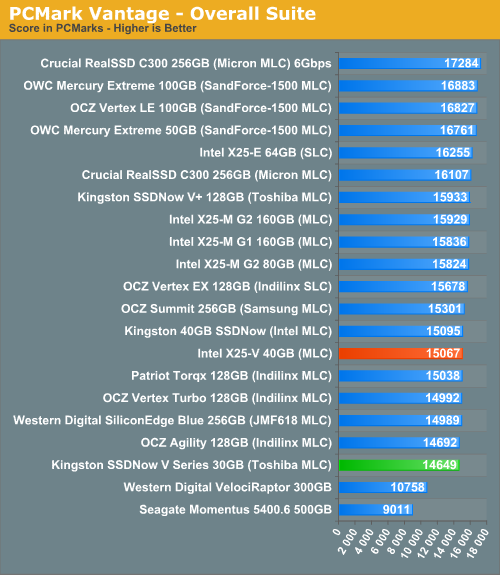
The Intel and Kingston value drives manage to stay close throughout almost all of the PCMark benchmarks. In the Productivity and HDD tests Intel manages to pull ahead by a noticeable margin however.
The memories suite includes a test involving importing pictures into Windows Photo Gallery and editing them, a fairly benign task that easily falls into the category of being very influenced by disk performance.
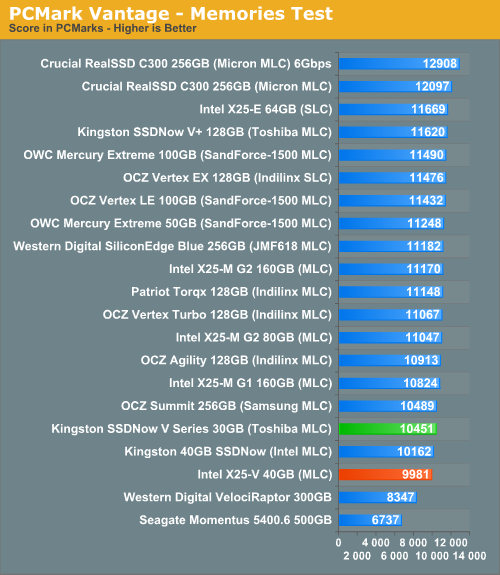
The TV and Movies tests focus on on video transcoding which is mostly CPU bound, but one of the tests involves Windows Media Center which tends to be disk bound.
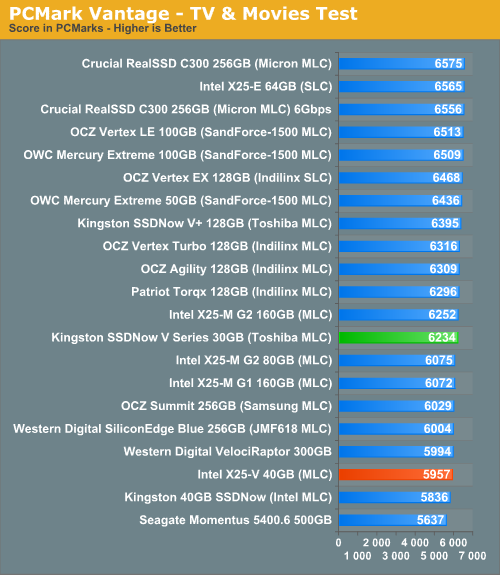
The gaming tests are very well suited to SSDs since they spend a good portion of their time focusing on reading textures and loading level data. All of the SSDs dominate here, but as you'll see later on in my gaming tests the benefits of an SSD really vary depending on the game. Take these results as a best case scenario of what can happen, not the norm.
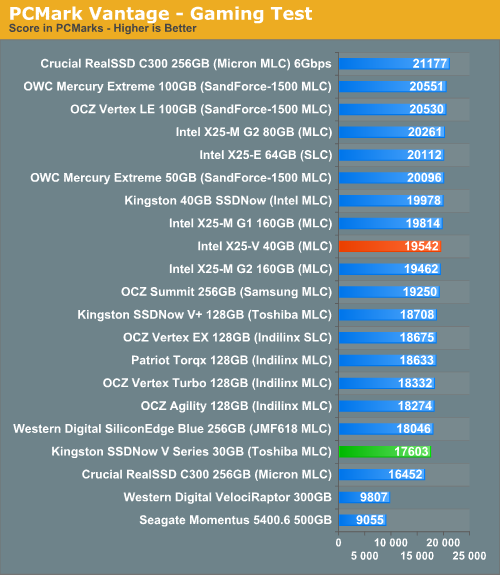
In the Music suite the main test is a multitasking scenario: the test simulates surfing the web in IE7, transcoding an audio file and adding music to Windows Media Player (the most disk intensive portion of the test).
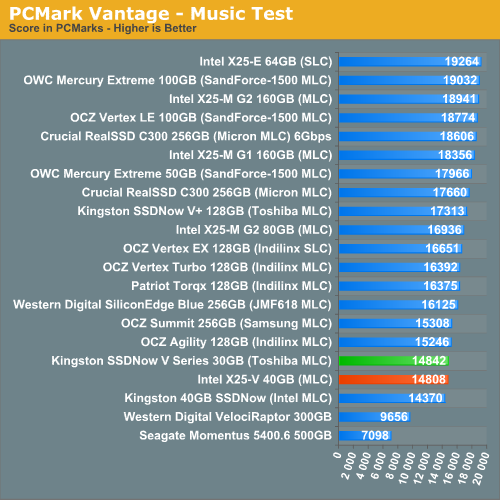
The Communications suite is made up of two tests, both involving light multitasking. The first test simulates data encryption/decryption while running message rules in Windows Mail. The second test simulates web surfing (including opening/closing tabs) in IE7, data decryption and running Windows Defender.
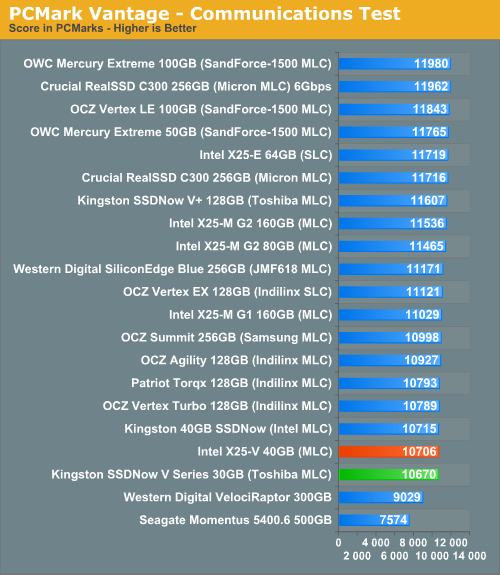
I love PCMark's Productivity test; in this test there are four tasks going on at once, searching through Windows contacts, searching through Windows Mail, browsing multiple webpages in IE7 and loading applications. This is as real world of a scenario as you get and it happens to be representative of one of the most frustrating HDD usage models - trying to do multiple things at once. There's nothing more annoying than trying to launch a simple application while you're doing other things in the background and have the load take forever.
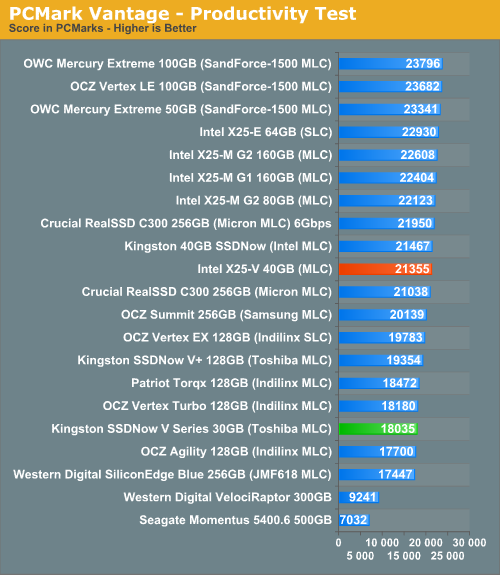
The final PCMark Vantage suite is HDD specific and this is where you'll see the biggest differences between the drives:
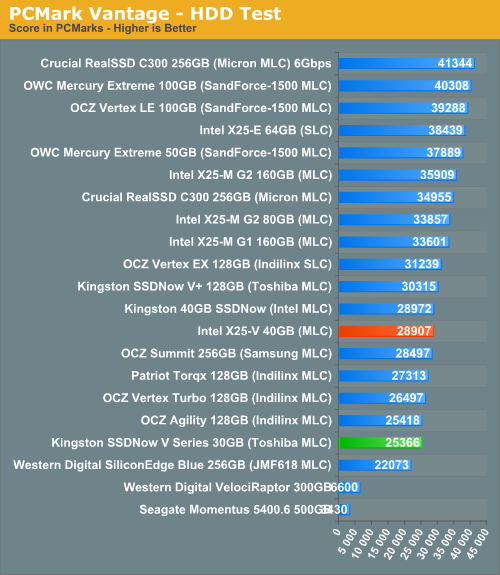










78 Comments
View All Comments
samspqr - Monday, March 22, 2010 - link
I agree with your posts on the other thread: I don't care about IOPS, just like getting more points in a benchmark won't make me happy by itselfI'm totally in the dark with respect to SSDs so far; with things as they are now, I guess I'll have to wait till I get my hands on one of them and can do my own testing (general feeling, then 3D rendering, video editing and encoding)
Taft12 - Saturday, March 20, 2010 - link
Rendering performance is not really an important bechnchmark for a general desktop computing website such as this.samspqr - Monday, March 22, 2010 - link
well, if it is in the CPU reviews, then it could be here too, coudn't it? at least if they found out that there's some difference, which is why I'm askingsamspqr - Friday, March 19, 2010 - link
here it is:http://www.3dprofessor.org/Reviews%20Folder%20Page...">http://www.3dprofessor.org/Reviews%20Folder%20Page...
they halved the rendering times by moving from a Western Digital 1TB RE-2 to a velociraptor, on a dual QX9775 board
soltari - Friday, March 19, 2010 - link
The kingston (intel) 40gb bootdrive was an awesome drive while it lasted. Mine actually did arrive last december with trim firmware on it, to my pleasant surprise. However after it died after purring along for 10 days and faced with no replacement possibility due to intel now wanting to sell only their identical more expensive drives i had to get a new one and for sure wasnt going to pay 35 dollars more to get the same drive back. An OCZ vertex 60gb is doing the purring now without issues.still the small SSD drive to run your O.S. from is an amazing improvement to overall performance. For this these new small cheap drives are great.
davepermen - Friday, March 19, 2010 - link
I use the X25-V in a Media Center setup (all actual data over the (gb) network). the -V delivers absolutely stunning performance, resulting in a fast to boot, very snappy system. and it has enough spare space for recording tv before it gets shifted to the winhome server.i could never get the kingston solution when seeing it's random performances. it's imho the main thing that makes an ssd feel fast. the media center is always "there", always "reacting". and even while the 40MB/s write speed is slow, the fact that it delivers nearly constant 40MB/s no matter if it's sequencial or random does it still perform quite fast (faster than hdds) in most real life cases (like installing the os).
i'm happy to get 10GB more space for the same price (a big thing in such low-storage devices), and i'm happy to get the overall more snappy and responsive performance.
for me, it's Intel: 1, Kingston: 0.
Shadowmaster625 - Wednesday, March 24, 2010 - link
Just like anand, here is another example of mindless intel worship.1. They arent the same price. One is 30% cheaper.
2. For media center applications, either would work perfectly fine, so obviously you dont know what you're talking about.
dagamer34 - Friday, March 19, 2010 - link
So definite improvement when using an SSD in media center? I've been meaning to get one, but didn't think that my primary apps could fit in 40GB. Seems a bit small.buzznut - Monday, March 22, 2010 - link
It depends on your install. You can easily get a win7 installation down to 10 gigs by turning things off like system restore, page file, and hibernation.I use the 40GB Intel drive and have Win7 pro, Office, flash, and any number of small productivity apps plus Heroes V with all the expansions. 15GB free atm, plenty of room to add PowerDVD and whatnot.
kmmatney - Friday, March 19, 2010 - link
" You gain better sequential performance and concurrent IOPS, but you have no way to actively curb performance degradation. "Can you schedule the SSD Toolbox to perform a manual TRIM. WOuldn't be so bad then - set it to run once a week and forget about it.
I have to say, Intel wins this round, easily. The Kingston would have had to perform much better to make up for the smaller drive size. I would expect that the Kingston will have to come down in price to remain competitive.